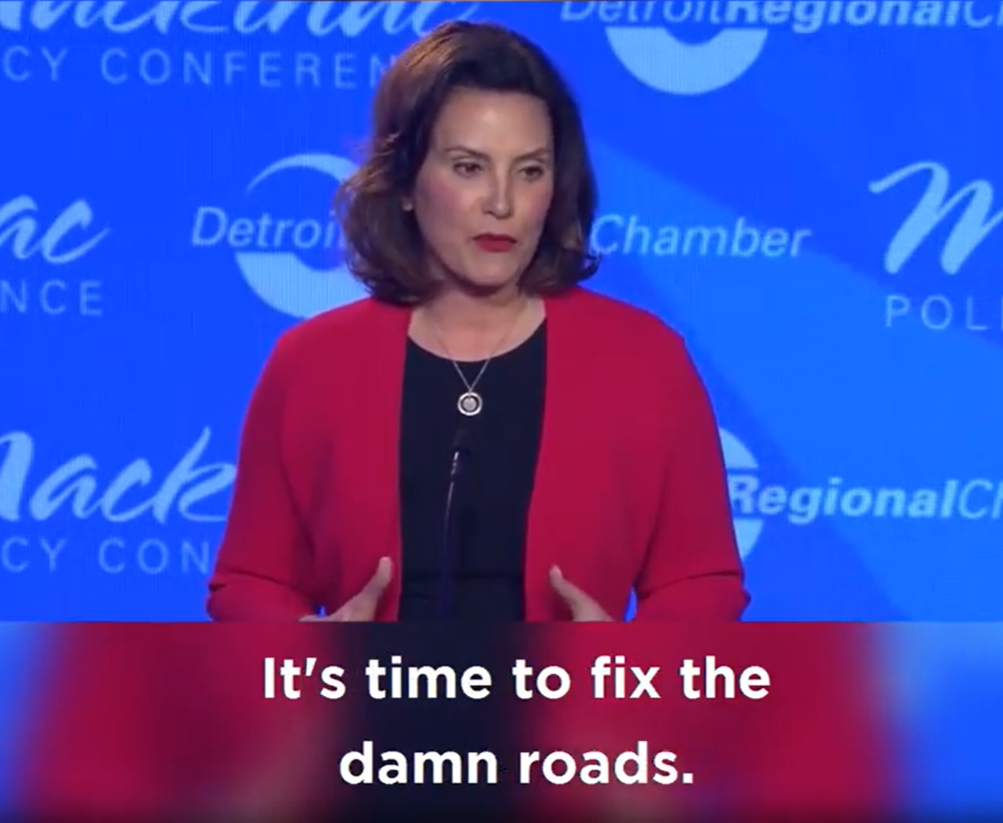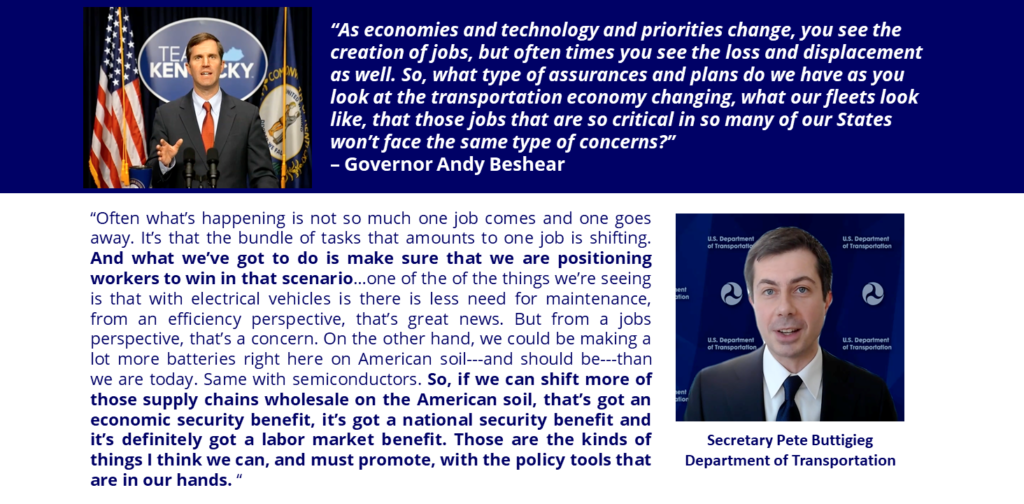Governors struck a resoundingly bipartisan tone before the Senate Environment and Public Works Committee, speaking to the urgency of investing now and for the future as our infrastructure must rapidly modernize to adapt to changing conditions.
by Thomas Curtin and Richard Lukas
As the Biden Administration spells out its priorities and eyes begin to turn toward a post-COVID-19 economic recovery, momentum is building for a comprehensive infrastructure plan. Governors from across the country are championing the importance of investing in infrastructure to spur the nation’s economy, and highlighting bipartisan solutions to move the nation forward.
Last week, Maryland Governor Larry Hogan and Michigan GovernorGretchen Whitmer spoke to the Senate Environment and Public Works (EPW) Committee at the committee’s first meeting of 2021.
Fresh off his 2019-20 NGA chairmanship, Gov. Hogan called attention to his Chair’s Initiative: Infrastructure: Foundation for Success. Framing the importance of this critical investment, Gov. Hogan told the committee that “sound policies and wise infrastructure investments promote economic recovery, facilitate the movement of essential goods and freight, ease congestion, and benefit residents and businesses alike for generations to come.”
Earlier this week @GovLarryHogan presented recommendations to @EPWCmte for repairing and modernizing America’s #infrastructure
— NGA (@NatlGovsAssoc) February 26, 2021
Learn more: https://t.co/iNyoklcGG0 pic.twitter.com/lSrvIzrkj3

Gov. Whitmer held true to her moniker as the “Fix-the-Damn-Roads Governor” and placed the issue in a global context, telling the committee that, “focusing on electric trucks, buses and cars – and the batteries that will propel them – will create jobs for the future, clean the air, and help us compete with Europe and China in this rapidly expanding market.”
The Governors struck a resoundingly bipartisan tone, speaking to the urgency of investing now and for the future as our infrastructure must rapidly modernize to adapt to changing conditions. Gov. Hogan noted that the pillars of his NGA Chair’s Initiative “work and have vast bipartisan support because Republican and Democratic Governors have been implementing them successfully for years.”
Both Governors took the opportunity to tout wide-ranging infrastructure investments made by their administrations in their respective states. Gov. Whitmer highlighted her state’s $3.5 billion bonding program, Rebuilding Michigan, “to help rebuild the state highways and bridges that are critical to the economy and carry the most traffic.” Gov. Whitmer noted that “when all of the $3.5 billion in bonds are sold over the next few years, they will finance or help accelerate rebuilding or major rehabilitation of hundreds of major highway segments across the state.” Highlighting Michigan’s rich transportation history and talented engineering workforce, Gov. Whitmer spoke several times about Michigan’s work with electric vehicles and her newly created Office of Future Mobility and Electrification.
“We are establishing a sustainable, customer-focused transportation vision for our highway, rail, bus, air, and port infrastructure. We also are striving to implement data-driven solutions to mitigate hazards and ensure the safety of the transportation network.”
Governor Larry Hogan
Gov. Hogan drew attention to investments in Maryland’s Port of Baltimore and BWI Thurgood Marshall Airport as critical to support the supply chain during the COVID-19 crisis, as well as the transformative Howard Street Tunnel project, which will “[remove] the last pinch point for double-stacked containers on rail along the East Coast by expanding [the facility].” Gov. Hogan also discussed Maryland’s success with public-private partnerships, which he noted can “leverage the power and creativity of the private sector to fund and deliver projects that meet critical needs, on top of allowing us to stretch scarce dollars even further.”
Governors Provide Congress Bipartisan Input at a Critical Time
The Governors’ comments come as the American Society for Civil Engineers released its 2021 Infrastructure Report Card this week, and the Biden Administration continued bipartisan discussions with Governors and Congress about the prospects for an infrastructure package.
In 2020, Congress passed a series of COVID-19 relief packages that provided more than $63 billion for transportation and infrastructure programs, including $39 billion for transit providers, $10 billion for state departments of transportation, $11 billion for airports, and $2 billion for Amtrak.
President Biden and congressional Democrats have prioritized the need for an infrastructure package that goes beyond the relief funding. President Biden has outlined a $2 trillion proposal of infrastructure projects ranging from roads and bridges to public transit systems and the electrical grid. An infrastructure package could be attached or framed with future economic relief and stimulus. In 2019, NGA released its Principles For National Infrastructure Investment, which spell out the bipartisan priorities of Governors and will help steer NGA’s advocacy as a bill is negotiated.
On Feb. 2, the Senate approved by a vote of 86-13 the nomination of Pete Buttigieg to be the secretary of Transportation. During his confirmation hearing, Secretary Buttigieg emphasized that in addition to infrastructure’s role in the country’s economic recovery, his top priorities as secretary would be maintaining safety and dealing with the climate and technological challenges of the future.
At the @EPWCmte yesterday, @GovWhitmer discussed #EVs with @SenatorCarper. For more on EVs see our December report on “Planning For Electric Vehicles By Managing Grid Interactions” https://t.co/2xfGlcKc1m
— NGA (@NatlGovsAssoc) February 25, 2021
and presentations from our September workshop: https://t.co/zrSodNC0uT pic.twitter.com/v2gSgtuppq
In terms of a larger infrastructure package, Secretary Buttigieg said that “the Department of Transportation can play a central role in this, by implementing President Biden’s infrastructure vision — creating millions of good-paying jobs, revitalizing communities that have been left behind, enabling American small businesses, workers, families and farmers to compete and win in the global economy, and tackling the climate crisis. Infrastructure can be the cornerstone to all of this, and you have my commitment that I will work closely with you to deliver the innovation and growth that America needs in this area.”
“With bold policy direction and a commitment to sufficiently invest in our future at the federal level…states can respond and help the Federal Government implement a bold, modern infrastructure foundation upon which our nation’s economy can grow and flourish for decades to come, and all the while, support a commitment to improving the environment and lives of our citizens.”
Governor Gretchen Whitmer
While the content of a prospective package remains undecided, it is expected that infrastructure will be among the highest priorities following passage of the next COVID-19 relief legislation. Leadership in the House and Senate have signaled that an infrastructure bill could take shape by Memorial Day with passage potentially before summer. The current surface transportation authorization, the FAST Act, runs through Sept. 30, 2021. The relevant Senate and House committees will take up a new surface transportation bill, and modeled after the attempted legislation in the previous Congress, the new bills will likely contain new proposals on climate issues and safety provisions. In 2020, the House passed the Moving Forward Act, a $1.5 trillion infrastructure package put forward by House Democrats, and in 2019, the Senate EPW Committee unanimously passed a transportation authorization. The House bill had a significant focus on climate issues and included increased funding for cities and transit systems, while the Senate bill took a more traditional approach on state formula funding with additional grant programs for resiliency. Senator Tom Carper (D-Delaware), the new chair of the EPW Committee, has indicated his intention to use that bipartisan Senate text as a starting point in negotiating a new bill and will look to strengthen the legislation on areas of climate, safety and electric vehicles.
Importantly, surface transportation issues are not the only infrastructure priorities that Congress and the Administration hope to address this year. While Congress will not consider another Water Resources Development Act reauthorization until 2022, it is likely that the House and Senate will both pursue substantial water infrastructure legislation. Legislators are likely to consider reforms to key drinking programs that states rely upon for funding and providing additional support for PFAS cleanup efforts.
In the coming weeks and months, NGA, led by its Economic Recovery and Revitalization Task Force, will continue to engage the Hill and the Biden Administration to advocate for Governors’ infrastructure priorities as the nation looks to recovery and rebuilding.













